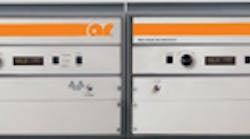Broadband amplification is essential in modern test laboratoriesespecially with regard to electronic-warfare (EW) and radar systems. Because traditional EW applications cover 2 to 18 GHz, a test power amplifier must at least span that frequency range, with adequate power to exercise both passive and active components. To meet these needs, Amplifier Research has announced a series of dual-band amplifiers with frequency coverage from 0.8 to 18.0 GHz.
Although the focus of this article is on the broadest-bandwidth models of the new dual-band xx/xxS1G18 series amplifiers (see figure), the company is also offering dual-band models for use from 0.8 to 10.6 GHz or 0.8 to 8.0 GHz, as well as from 0.8 to 18.0 GHz; all have a range of output-power levels from 5 to 80 W. Note that those higher-power ratings apply to the lower-frequency band of the two amplifiers in the series cabinet. The frequency bands are broken into 0.7 to 4.2 GHz and 4 to 18 GHz in the most broadband amplifiers (see table).
All of the amplifiers are air cooled and will reach their rated output-power levels with an input signal of only 1 mW (0 dBm). The 50-O amplifiers are extremely rugged, rated for mismatch tolerance of 100% of rated power without foldback. They are designed with outstanding linearity and will maintain the fidelity of common modulation formats.
The performance levels are similar from amplifier to amplifier. For example, for a model 20/20S1G18, which is rated for 20 W output power in both low- and high-frequency bands, the low band (0.7 to 4.2 GHz) offers 20 W minimum output power with 22 W output power at 1-dB compression and 25 W output power at 3-dB compression. The amplitude flatness is typically 1.5 dB and worst case of 2.0 dB from 0.7 to 4.2 GHz. The low-band amplifier offers 43 dB gain at the maximum output setting, with 10-dB typical noise figure and -20 dBc harmonics. The linearity is characterized by a typical third-order intercept point of +52 dBm.
| The dual-band power amplifiers at a glance | ||
| Model | Output Power | |
| 0.7 to 4.2 GHz | 4 to 18 GHz | |
| 20/10S1G18 | 20 W | 10 W |
| 20/20S1G18 | 20 W | 20 W |
| 40/10S1G18 | 40 W | 10 W |
| 40/20S1G18 | 40 W | 20 W |
| 60/10S1G18 | 60 W | 10 W |
| 60/20S1G18 | 60 W | 20 W |
| 80/10S1G18 | 80 W | 10 W |
| 80/20S1G18 | 80 W | 20 W |
For the higher-frequency band (4 to 18 GHz), the amplifier is also rated for minimum output power of 20 W, with 22 W output power at 1-dB compression and 25 W output power at 3-dB compression. The amplitude flatness is typically 3 dB from 4 to 18 GHz, with worst-case performance of 4 dB. The high-band amplifier provides 44 dB gain at its maximum setting, with harmonic performance of -20 dBc. The typical third-order intercept point is +49 dBm through 18 GHz.
All amplifiers are rated for spurious level of -73 dBc and supplied with Type N input and output connectors. They feature a full array of control and monitoring connections, with a 24-pin IEEE-488 (GPIB) connector, a USB 2.0 connector, an RJ-45 Ethernet connector for local area networks (LANs), and RS-232 9-pin subminiature D and fiber-optic connectors. The dual-band amplifiers measure 19.8 x 13.5 x 24 in. (50.3 x 24.3 x 61 cm), and draw maximum power of 600 W from a supply of 90 to 264 VAC.
Amplifier Research
160 School House Road.
Souderton, PA 18964
(215) 723-8181
FAX: (866) 859-0582
